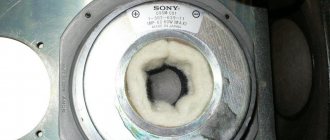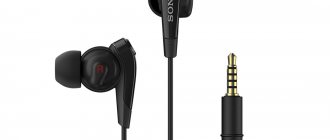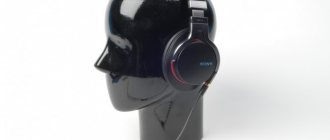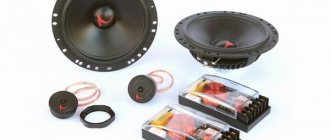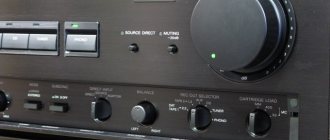In May of this year, Sony released a new line of Mobile ES car audio components. Let's start by introducing you a little closer to the model range. The Mobile ES line includes a total of 5 different speakers: 3 coaxial speakers, 1 component speaker and 1 subwoofer. We assume that the manufacturer's main goal was to create the most flexible range possible and cover the most commonly used sizes and shapes that can be found in a wide variety of cars.
Composition of the Sony Mobile ES line:
- XS-162ES: 6.5" 2-way component speakers
- XS-160ES: 6.5" 2-way coaxial speakers
- XS-690ES: 2-way coaxial speakers 6x9 inches
- XS-680ES: 2-way coaxial speakers 6x8 inches
- XS-W104ES: 10" subwoofer
When comparing 6.5" coaxials to 6×8" coaxials, it's safe to say that these speaker combinations will fit any vehicle, both in size and power.
As for the subwoofer, Sony only offers one size option - 10 inches (25 cm). This is probably because it is Sony's most sophisticated sub, delivering excellent peak power for its size.
Powerful bass is not the only goal that Sony was aiming for with its series of car speakers. Well-balanced, detailed, full vocals and accurate reproduction of instrumental lines are the key features of the Mobile ES systems.
However, we hope to see a 12-inch woofer from Sony in the future. This is the most universal size, the main thing is to find a place for it. In the meantime, if you want more bass, just buy two XS-W104ES subwoofers.
Checking the sound of the Mobile ES speakers
The components of the Sony Mobile ES line are filled with many interesting features that are quite rare in devices of this category. Most of the technology is proprietary to Sony. The developer presented them for the first time in the Mobile ES series components. The result is a really cool looking and performing sound package with a powerful subwoofer.
Most of the descriptions of the new functions and features are presented in a rather technical form, and in order to understand them, you need to clearly understand how the speaker is designed and how it works.
Here are some of the most notable features of Sony's new lineup of speakers. To begin with, here is a diagram of the speakers, on which the subsequent points of our digest are marked with numbers, in which we will consider the design features of this element of the system. Simply match the numbered object with the corresponding item.
Let's start with the so-called “common features” that the subwoofer and speakers have in common.
#1 Curved Notch (Separated Notch Edge Technology)
This is one of those innovative solutions that has not been used in any device before the Mobile ES. In all the Sony speakers that we saw and heard, the surround sound was at a very high level. Obviously, this is a merit of Sony proprietary technologies. But the manufacturer doesn’t stop there either.
Our understanding is that the grooved surround allows the driver to move vertically with greater precision and symmetry, effectively giving the cone a higher X-max.
X-max is the movement of the cone along the axis forward and backward. The more of these movements it makes during operation, the more air it pushes out, thus providing louder and clearer sound.
In theory, this rationale makes sense, since these notches reduce the volume of the suspension and likely help reduce the friction that occurs when the diffuser moves. Everything would be fine if it weren’t for the issues related to durability and strength. The design with notches is much thinner, and, as practice shows, the suspension is the first part of the body that fails dynamically. This happens especially often in dry climates. It is worth noting that the grooves and phasing core look quite stylish and elegant, so we decided not to cover them with grilles.
#2 Dynamic diffuser
The Dynamic Air Cone is one of the new design features of Sony speakers. It consists of adding ventilation holes that perform two main functions:
Allows air to flow through the back of the speaker more efficiently. This helps reduce any build-up of air pressure that may occur in the area of the structure behind the cone.
Cool the voice coil. These speakers do not have an overheat sensor that turns them off to prevent possible damage, a mechanism often used in amplifiers. Thus, this design allows air to circulate freely, allowing the speaker to operate within a safe temperature range even under heavy load.
#3 Progressive speed centering washer
The centering washer is a design element that prevents the inner axial part, called the core, from moving laterally and touching the magnet. It must be rigid and strong both horizontally and provide enough vertical support to allow the woofer to move freely and produce accurate sound. Sony's progressive lift washer was designed to allow the woofer to move with greater precision and deliver powerful sound without compromising the cabinet.
The height, angle and shape of each wave can significantly affect the sound, as the resulting resonances ultimately create the movement of the cone. The features of a centering washer really come down to the choice of materials used and its shape/design. These are the aspects that will differentiate speakers from one manufacturer from another.
It's hard to draw any conclusions about the performance of the centering washer when you're just looking at or listening to the speaker, but it's an incredibly important component of the system.
We emphasize that Sony develops / optimizes the puck for each individual product. So the spider in their 6.5" coaxials is a little different than what they use in their 6x9" speakers. Many manufacturers prefer to use one type of washer for several models at once because it is cheaper and also requires less time and effort. Sony engineers use computer modeling to design the ideal spider shape for each product, then further refine them through extensive sound testing.
So, even if you may not be able to see (or rather, hear) a significant difference, we assure you that the centering washer and core do play a big role in the overall sound quality. The fact that Sony spends its time and money on individually optimizing components for each product is another example of how this line of car speakers differs from most speakers on the market today, even from other Hi-Res sets.
#4 Five-rib design
The speaker's basket is its foundation, the frame on which everything rests. Like a car's frame, the basket acts as a stabilizer that prevents resonances and vibration, breakage and other problems that can occur while the engine is running. Four-beam designs are more common in the speaker world, while five-beam designs are less common.
The five-rib frame design not only provides additional rigidity and strength, but also limits the amount of unwanted resonance that occurs in speakers with a flimsier, more flexible frame. Otherwise, it can warp, vibrate, and ultimately negatively impact the speaker's performance, its sound signature, and the system's ability to produce accurate sound.
Correspondence of model names of Sony amplifiers between Japanese and European versions
Sony sold integrated amplifiers not only locally in Japan, but also around the world in Europe.
When buying a Japanese model, you should additionally take care of purchasing a step-down transformer from 235 to 100 volts. Therefore, we come to the conclusion that if it is possible to purchase a European version of the amplifier, then it may be more preferable. This is not always the case, because export models may be simplified in order to reduce their cost or weight, because sending a model weighing 13 kg and 21 kg across the world is a different cost. Therefore, for example, under the guise of the Yamaha A-1000 amplifier, a lower level model was sold in Europe - the Yamaha A-950, which was called the Yamaha A-1000 (Europe). In this case, it will be more interesting to purchase the original Japanese amplifier model.
Whether there were such simplifications with models from Sony is impossible to answer without a deep study of the question. I can only say that the interesting Sony TA-F444ESX model with its unusual number 444 is still the same Sony TA-F333ESX, which has undergone export collisions in the name.
Based on Sony integrated amplifiers, I can say that these are very high-quality, seriously made devices with decent sound quality. The special dawn of sound of the 333-777 series occurred in the 90s (although you can hear that the industry was stagnant and moving towards home theaters). How did this become possible?
Back in 1973, the release of the SONY TA-8650 model for ¥295,000 impressed audio lovers with its sound due to the use of special V-Fet transistors, which were, I think, the MOSFETs you know, but only with a vertical gate arrangement, as evidenced by the letter V - vertical.
In 1976, more affordable V-Fet models appeared - SONY TA-4650 (¥84,800). At the same time, the more primitive models 3650 and 2650 were equipped with bipolar transistors.
The success was consolidated by the top model on V-Fet - SONY TA-F7 for 178,000 (1977).
The idea of using MOSFET variations absorbed Sony and it used new options in 1978 - the top-end SONY TA-F80 amplifier costing ¥158,000, which used Hi-Fet.
By analogy, we can assume that we are talking about a classic MOSFET with a horizontal arrangement. The main difference was the frequency of the transistor - 60 MHz, while previous models had a frequency of 20 MHz, and transistors common on the market, widely used by other companies, were 4 MHz.
These qualities gave an amazing sound. One of the features of the Mosfet sound is the solidity of the sound, a confident low-frequency base and naturalness of the sound.
It is worth noting some disadvantages of MOSFET type transistors - this is the fear of static electricity.
Decades later, only one problem can hypothetically arise for the SONY TA-F7/6 models - V-Fet transistors are no longer produced in our world and you will have to look for a donor.
Further in the history of Sony, the period of using bipolar transistors begins - they are fast, they are detailed, but not so spiritual in sound, not so natural in specific models.
And only in 1990, Sony again triumphantly returned to the market with a model based on MOS FET - and this is the magnificent Sony TA-F333ESL and of course the Sony TA-F555ESL (which I personally like less - the increased resolution is a plus, but the loss of density and liveliness of sound - of course minus, against 333esl - thick and natural).
Sony's MOS FET amplifiers are a step higher in sound perception compared to integrated amplifiers based on bipolar transistors. However, other companies usually reserve MOS FETs only for premium-level amplifiers, sometimes combining them with bipolar ones to give interesting characteristics (as Denon does).
You can also notice that more modern Sony models have decreased in weight due to the abandonment of chassis hybrothers, but in terms of sound they have improved, even the initial models began to work on MOS FET transistors.
When comparing the top-end amplifier SONY TA-F555ESX with the pre-top amplifier SONY TA-F50ES, the sound of the 50ES was more preferable due to the MOSFET and greater accuracy in working with sound material.
SONY TA-F50ES
Below I will provide a list (not compiled by me) that indicates different names for the same models in Japan and Europe. For Japanese models, I have added the price in Japanese Yen to the list.
15.0 kg 1982 Sony TA-F555ES ¥99,000 19.0 kg 1983 Sony TA-F777ES ¥185,000 13.5 kg 1984 Sony TA-F333ES ¥79,800 17.5 kg 1984 Sony TA-F555ESII ¥128, 000
13.2 kg 1986 Sony TA-F222ESX (¥67,000) = Sony TA-F500ES 18.6 kg 1986 Sony TA-F333ESX (¥79,800) 18.3 kg 1986 Sony TA-F444ESX = Sony TA-F700ES 26.0 kg 1986 Sony TA -F555ESX (¥128,000)
19.6 kg 1987 Sony TA-F333ESXII (¥79,800) 27.8 kg 1987 Sony TA-F555ESXII (¥128,000)
13.5 KG 1988 Sony TA-F222SR (¥ 50.700) = Sony TA-F530S 19.9 KG 1988 Sony TA-F333ESR (¥ 79,800) = Sony TA-F730S 24.5 KG 1988 Sony TA-F555SR (¥ 128,000) = SONY TA -F830ES
13.7 kg 1989 Sony TA-F303ESD (¥64,600 is 222ESR with built-in DAC) = Sony TA-F630ESD 14.0 kg 1988 Sony TA-F505ESD (¥99,800 is 333ESR with built-in 48kHz DAC)
21.5 kg 1989 Sony TA-F333ESG (¥79,800) 24.5 kg 1989 Sony TA-F555ESG (¥128,000)
21.3 kg 1990 Sony TA-F333ESL (¥85,000) = Sony TA-F770ES 24.0 kg 1990 Sony TA-F555ESL (¥138,000) = Sony TA-F870ES
11.6 kg 1991 ……………………../ Sony TA-F550ES 11.8 kg 1991 ……………………../ Sony TA-F650ESD
12.0 kg 1991 Sony TA-F222ESA (¥49,800) = Sony TA-F570ES 21.3 kg 1991 Sony TA-F333ESA (¥90,000) 24.6 kg 1991 Sony TA-F555ESA (¥150,000) 12.5 kg 1991 … …………………./Sony TA-F670ES
12.0 kg 1992 ……………………./ Sony TA-F590ES 12.5 kg 1992 …………………………./ Sony TA-F690ES
21.3 kg 1992 Sony TA-F333ESJ (¥90,000) = Sony TA-F707ES 24.6 kg 1992 Sony TA-F555ESJ (¥150,000) = Sony TA-F808ES 14.0 kg 1993 Sony TA-F222ESJ (¥49,800) = Sony TA-F505ES
14.0 kg 1993………………………./Sony TA-F606ES
10.0 kg 1995 Sony TA-FA3ES (¥60,000) 17.5 kg 1995 Sony TA-FA5ES (¥98,000) = Sony TA 19.8 kg 1995 Sony TA-FA7ES (¥180,000) = Sony TA-FA70ES
11.0 kg 1998 Sony TA-FA30ES (¥60,000) = Sony TA-FA33ES 20.5 kg 1998 Sony TA-FA50ES (¥98,000) 23 kg 1998 Sony TA-FA70ES (¥180,000)
23.0 kg 1999 Sony TA-FA777ES (¥200,000)
The models that deserve attention from the list are copies of amplifiers 333-555 and 777. Such simple models like 630ESD will not reveal any revelations to you - these are very budget-friendly and uninteresting options. Therefore, it makes sense to consider an amplifier starting with 3ES or 333.
Speaker Features
The following functionality only applies to speakers, that is, these components are not included in the subwoofer.
#5 Synthetic soft dome tweeter
Tweeters typically have two types of domes: soft and hard. A hard dome is usually made of various metals (aluminum, titanium) or mica. Tweeters with this type of dome have a sharp and distinct high-frequency sound. At first, to the untrained ear, it may seem that titanium and aluminum domes can even be too rigid in certain areas, but over time you will quickly get used to this. In addition, hard domes are more resistant to resonance due to the strength of the materials.
Soft dome tweeters obviously sound softer. They are better suited for home audio systems and listening to music in enclosed spaces where the listener is in close proximity to the sound source (such as a car). Soft dome tweeters are definitely our personal preference when choosing a tweeter for cars.
XS162ES
Sony uses synthetic fabric to make the dome; we did not receive a more detailed description of the materials. Depending on whether you buy one of the coaxial speakers or a component speaker, the tweeters will either be mounted in the center of the woofer (coaxial) or the woofers and tweeters will be completely separate (component).
Coaxial speakers come with two different sized tweeters, depending on the model you buy:
- The XS-162ES and XS-690E come with a 1-inch neodymium magnet tweeter.
- The XS-160ES and XS-680ES come with a 13/16-inch soft dome tweeter.
If you choose not to cover the front of your coaxial speakers with a protective grille, we advise you to be especially careful with anything that could snag or otherwise puncture the synthetic fabric. Sony's tweeter dome is designed to be lightweight, precise, and deliver ultra-high frequencies (up to 40,000 Hz). But the soft dome has its drawbacks: it is prone to damage, so it is better not to neglect the use of the included grilles.
#6 Diffuser material MRC
The woofer, or more precisely its cone, is made of so-called mica-reinforced composite (MRC). Each major manufacturer does have their own proprietary composite technology that they develop and thoroughly test.
If we talk about the cone of the ES series speakers, here the manufacturer used a standard cellulose frame and reinforced it using the mica sintering method (MRC). As a result of the heat treatment of the composite, the paper diffuser became indistinguishable from the pressed metal cone.
Generally speaking, manufacturers are constantly looking for ways to improve the performance of their components, such as reducing weight and increasing rigidity through the use of new materials. Sony, as a manufacturer, is constantly searching for optimal solutions for the woofer, experimenting with manufacturing methods and material combinations.
It is worth noting here that the Mobile ES speakers use a mica mixture, which is Sony's proprietary solution as a material for their speakers. We can confidently say that this composite is superior to most of the materials we're used to, like pure polypropylene, and since they developed it, you know that they also carefully tuned it to match the other components of the system as closely as possible. Moreover, the charcoal black body is very well made and looks amazing.
Music Elite: Sony TA-ZH1ES DAC/Headphone Amplifier Review
Sony has dominated the personal audio space since the introduction of the first cassette Walkman. And today she has no intention of losing her position to ambitious newcomers from China and South Korea! This season, the company is taking all measures to strengthen its position in the premium segment of this promising market. This important mission is entrusted to the top-of-the-line Signature Series, which the company presented at the recent IFA. Today we will take a look at the most solid device from this line - the TA-ZH1ES DAC/amplifier. It's time to find out why Sony has such hopes for this model! And why does he demand so much money for it?
Appearance
Metal body, black textured finish and no decorative frills - the appearance of the new model is recognizable by the same noble minimalism that marks its closest relatives from the Signature Series family. By the standards of home devices, the device is quite compact; it resembles a thick encyclopedia volume rather than a familiar High End box. But it is quite weighty: when you try to move the amplifier from its place, you immediately realize that its body is not stuffed with foam plastic at all. And indeed, the filling of the TA-ZH1ES contains so much metal that it would be enough for half a dozen simpler devices.
The solid chassis is made from thick aluminum and is designed to completely dampen vibrations, while the metal base is constructed as a double-layer sandwich to shift the center of gravity downwards and improve structural stability. The TA-ZH1ES's lid is also not simple - it is based on a combination of steel and aluminum, designed to eliminate resonances. It is on the cover that the main controls of the device are located, with the exception of the large volume knob, which remains on the front panel. The rest of the space on the front and rear panels is devoted to numerous inputs and outputs. There really are a lot of them here! Much more than most other high-end amplifiers get from the designers.
Switching
How many headphone jacks does a typical amplifier have? For most people, one or two are enough. TA-ZH1ES is a special case: its facade is crowded with half a dozen different-sized connectors, from the “folk” minijack to studio XLR4. Two of them are reserved for a standard, unbalanced connection of headphones, the other four are designed for a balanced connection, eliminating losses in the quality of the sound signal, regardless of the cable length. The explicit focus on balanced connectivity not only brings the TA-ZH1ES closer to other devices in the Signature Series line, but also provides them with the opportunity to work together.
This primarily applies to the flagship MDR-Z1R headphones, which include an additional balanced cable. On the rear panel there is USB-B for working in conjunction with a computer as a USB DAC, optics with coax for communication with other digital sources, as well as a linear input and output of a preamplifier. On the side is something more interesting: a digital interface for connecting to Walkman audio players and Xperia smartphones. Thanks to its thoughtful placement, the user does not need to fumble around with his hand on the underside of the DAC/amplifier when connecting his portable gadgets to it. After all, this can be done without unnecessary fuss, in just one simple movement!
Peculiarities
The power and amplification circuit of the TA-ZH1ES uses a number of interesting solutions that have been successfully tested by Sony designers on their top-end High-End audio components, but the most interesting is its digital-to-analog module. It is based on a gate array - a semiconductor device with the most flexible configuration, capable of developing maximum computing power when processing a digital audio stream. It is on such gate arrays that the most advanced audiophile solutions are built today - for example, the famous Chord digital-to-analog converters. In the TA-ZH1ES circuit, the gate array is responsible for converting any input signal into a one-bit DSD stream with an uncompromising resolution of 22.4 MHz. That's where this flagship device has such outstanding high-cut processing capabilities!
In addition to 22.4MHz DSD, it is ready to accept PCM with ultra-high 32bit/768kHz resolution, which is beyond the capabilities of the vast majority of today's DACs. In addition to its powerful arsenal for HD audio processing, Sony's new DAC/amplifier comes with a decent set of audio correction tools. In addition to linear phase correction with several operating modes, this set includes the proprietary DSEE HX processor, designed to correct frequency and dynamic losses during MP3 compression. The presence of this function in a High-End device may not seem entirely appropriate until you remember that one of the main tasks of the TA-ZH1ES is to work in tandem with portable devices. Thanks to the capabilities of DSEE HX, the owner of these devices will be able to squeeze out maximum sound quality from even the most compressed files!
Sound
The powerful amplifier part of the TA-ZH1ES allows it to successfully cope with any load in the range from 8 to 600 Ohms, so you don’t have to limit yourself in choosing headphones for testing. We gave the device the opportunity to show its abilities in conjunction with a motley set of planar Oppo PM-2, high-impedance Sennheiser HD600, and flagship Sony MDR-Z1R. From the Oppo PM-2, the amplifier achieves a dense and rich sound, in which sharpness in drawing details is harmoniously combined with integrity in the presentation of musical works. The slight lack of the lowest bass is compensated by the excellent speed and clarity of the low-frequency range, thanks to which the bass drum sounds with extreme elasticity and energy. The classic Sennheiser HD600, when connected to the TA-ZH1ES, begins to play so airy, relaxed and spacious that if not for the tight pressure of the cups, they could be confused with the flagship 800th model of the famous German company. The blurring of high frequencies, which some stereophiles mistakenly believe to be an inherent defect of the HD600, completely disappears.
In fact, these headphones have no high-frequency flaws, they just need a high-quality amplification path! But the most vivid impressions remain from the duet of the device with its closest relatives in the Sony Sound Signature family - the MDR-Z1R headphones. The sound of this combination amazes with a rare combination of scale and sophistication, thanks to which when listening to an orchestral recording with a resolution of 24-bit / 192 kHz, you experience about the same dizziness as when watching a science-fiction movie on the screen of a giant 8K TV. This sound is so rich in micro-details and so three-dimensional that the word “realistic” can no longer describe it. This is real hyperrealism! All instruments are clearly distributed around the stage, each instrumental part is easy to follow, and in every touch of a bow on a violin string or a finger on a piano key, so many details emerge that any musical fragment can be listened to endlessly. The main thing is not to forget to take breaks for sleep and food. Or at least just for sleep.
Eventually
This DAC/amplifier is capable of extracting the maximum musical potential even from relatively inexpensive headphones - it can not only bring out their advantages, but also smooth out their inherent shortcomings. And to get a truly strong impression, it’s worth listening to how it sounds paired with top models like the Sony MDR-Z1R. You definitely won’t forget this soon!
The Sony TA-ZH1ES amplifier is available for pre-order in Doctorhead stores from January 31, 2022.
Author:
(aleksandra) Alexandra Stetsishin 01/25/2017
Found a typo in the text?
Select and press
Ctrl+Enter
. This does not require registration. Thank you.
Share on social networks
Subwoofer Features
These features are unique to the subwoofer and are not available on the Sony Mobile ES series speakers.
#7 MRC Honeycomb
The MRC cone on Sony Mobile ES subwoofers is slightly different from the cones on component and coaxial speakers. For more detailed information about the composite itself, you should read the sixth item on the list.
XS-W104ES
The key feature is the wall thickness and the method of pressing the material. Sony uses a lot more fiber to strengthen the subwoofer cone (meaning we have more density and strength in the enclosure). You can also see that, unlike other speakers, the subwoofer's cone cover has a compressed fiber structure that resembles the honeycomb of a beehive.
The picture becomes more obvious up close. Sony claims that this cellulose cone reinforcement technology results in a driver that is "10 times stiffer than any other driver with a conventional polypropylene matrix cone." Rigidity is critical to preventing distortion at high volumes. 10x hardness is a strong statement, so the XS-W104ES subwoofer should blow listeners' minds with its uncompromising sound quality and low-end depth.
Read details on the website: https://www.sony.com/en/
Author of the publication
offline 2 hours





